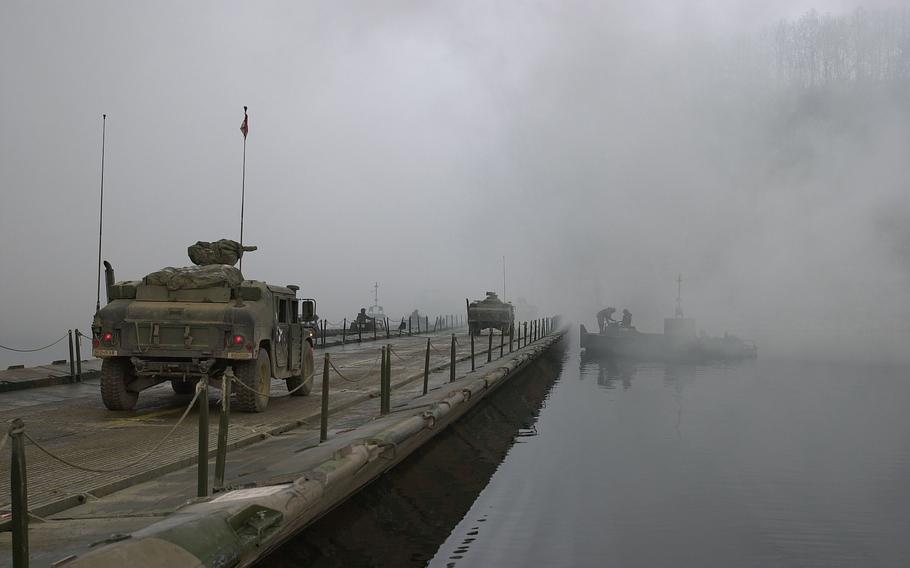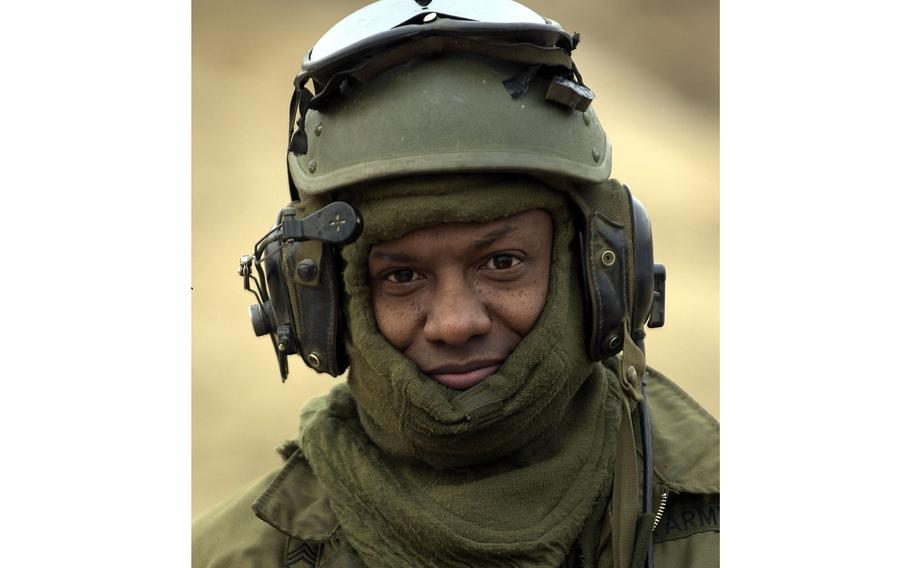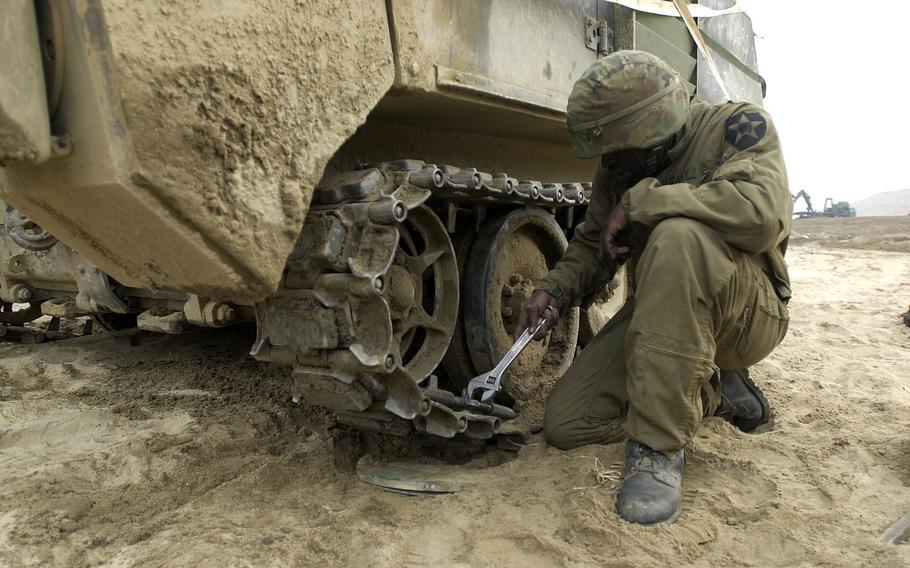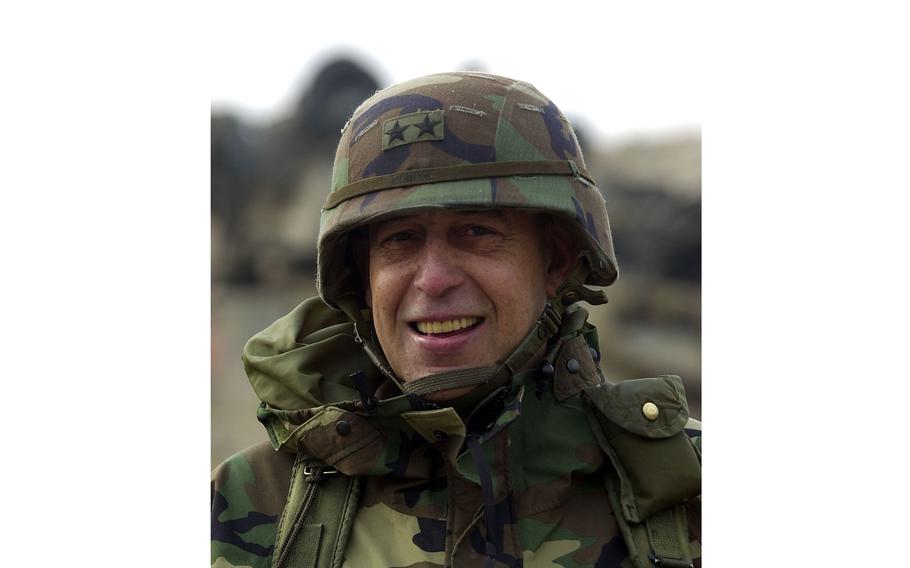
Shielded from view by smoke created by smoke track vehicles of the 4th Chemical Company, military vehicles cross the Imjin River. (Andy Dunaway/Stars and Stripes)
This article first appeared in the Stars and Stripes Pacific edition, Mar. 7, 2002. It is republished unedited in its original form.
The growl of engines and the rattle of wheels and tracks could be heard throughout the valley, but the vehicles could not be seen.
The Imjin River flowed somewhere down in the valley, but a heavy fog made it impossible to be seen as well.
Only by getting to the water’s edge, and following the sounds, was it possible to see that it wasn’t a fog covering the valley, but smoke pouring out of tracked vehicles driven by U.S. soldiers.
A long line of camouflaged vehicles steered down the riverbank and crossed a bridge to the opposite bank. The river-crossing was the final event of annual Army Training Evaluation Program maneuvers that put more than 5,000 soldiers from the 2nd Infantry Division in the field, some for as long as seven weeks.
The action began Friday [March 1, 2002] when UH-60 Black Hawk helicopters from the 2nd Battalion, 2nd Aviation Regiment conducted an air assault on the terrain north of the river. The helicopters carried 300 troops with anti-tank missiles, ammunition, water and food across the river to set up positions.
After the air assault, 70 soldiers from the 50th Engineer Company built a bridge across the 418-footwide river for the fourth time in two days. One span was built in total darkness.
“The bridge included 17 sections called bays, and a ramp section at each end,” said 1st Lt. Julie Campbell of the 50th Engineer Company. “Trucks carried the bays to the crossing site.”

Staff Sgt. Cleveland Guess, 1st Squad leader of the Smoke Platoon, 4th Chemical Company. "If our track breaks then we fix it ourselves." (Andy Dunaway/Stars and Stripes)
Soldiers then used bridge-erection boats to push the bays into position. During the night installation, heavy fog blanketed the river.
“It was so foggy we couldn’t see past the end of the boats, even with night-vision goggles,” said Spc. Keith Moose of the 50th. No one was hurt, but as a precaution, a safety boat patrolled each side of the bridge.
Saturday morning was cloudless and cool, but by 8:30 a.m. the sun still had not reached the bridge, thanks to the 4th Chemical Company. Nicknamed the Flamethrowers, they filled the riverbed and the surrounding valley with a mass of gray and white smoke.
Three-person crews drove smoke track vehicles, capable of gushing out smoke for 90 minutes.
“The smoke blocks the view from the enemy and protects against aircraft and artillery,” said Col. Joseph Martz, 1st Brigade commander.
On the south bank, a long line of Humvees and M2-A2 Bradley Fighting Vehicles inched down the rough road toward the bridge.

Army Pfc. Tamelle Hill, a smoke generator operator with the 4th Chemical Company, tries to repair a broken track in the soft sand. (Andy Dunaway/Stars and Stripes)
The Bradleys thumped across the bridge, the sound of their engines mixing with the hissing of the smoke tracks. As soon as one cleared the bridge on the north bank, the next began to cross.
“If they don’t get across the bridge safely, then we will not have them to use when we need them,” said Maj. Eric Welsh, 1st Brigade Combat Team operations officer. On Friday, 215 vehicles crossed; on Saturday, 419.
No one was shouting during the crossing; the soldiers hardly spoke to each other as they focused on their duties.
“A lot of learning took place here and the troops adjusted well to all the excitement and action,” said Maj. Gen. Russel L. Honoré, commanding general of the 2nd Infantry Division.

Army Maj. Gen. Russel L. Honoré, commanding general of the 2nd Infantry Division. (Andy Dunaway/Stars and Stripes)
“Our goal here was to get our soldiers safely trained and we accomplished that,” said Command Sgt. Maj. Kan Tong, of the 1st Brigade Combat Team.